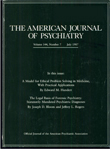Neuroanatomical correlates of happiness, sadness, and disgust
Abstract
OBJECTIVE: Happiness, sadness, and disgust are three emotions that differ in their valence (positive or negative) and associated action tendencies (approach or withdrawal). This study was designed to investigate the neuroanatomical correlates of these discrete emotions. METHOD: Twelve healthy female subjects were studied. Positron emission tomography and [15O]H2O were used to measure regional brain activity. There were 12 conditions per subject: happiness, sadness, and disgust and three control conditions, each induced by film and recall. Emotion and control tasks were alternated throughout. Condition order was pseudo-randomized and counterbalanced across subjects. Analyses focused on brain activity patterns for each emotion when combining film and recall data. RESULTS: Happiness, sadness, and disgust were each associated with increases in activity in the thalamus and medial prefrontal cortex (Brodmann's area 9). These three emotions were also associated with activation of anterior and posterior temporal structures, primarily when induced by film. Recalled sadness was associated with increased activation in the anterior insula. Happiness was distinguished from sadness by greater activity in the vicinity of ventral mesial frontal cortex. CONCLUSIONS: While this study should be considered preliminary, it identifies regions of the brain that participate in happiness, sadness, and disgust, regions that distinguish between positive and negative emotions, and regions that depend on both the elicitor and valence of emotion or their interaction.



